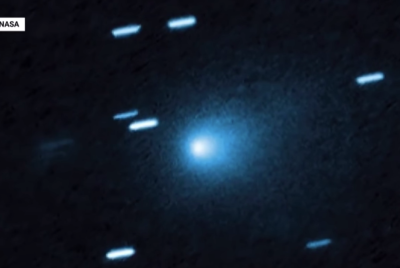Harvard Scientist Warns: This Comet Might Not Be Natural — Are We Looking At Alien Tech?

A leading Harvard scientist has reignited discussion about extraterrestrial technology after claiming the newly observed interstellar object 3I/ATLAS may not be natural.
Professor Avi Loeb, known for his controversial research into interstellar visitors, argues in a recent paper and statements that 3I/ATLAS exhibits 'anomalous characteristics' inconsistent with typical comets.
Discovered on 1 July 2025 by the ATLAS survey facility in Chile, 3I/ATLAS is the third confirmed interstellar object to enter the Solar System. Loeb and his collaborators estimate a 30–40 per cent chance that it is not natural, suggesting, albeit speculatively, that it could be an artificial artefact.
According to his analysis, the comet's retrograde orbit, trajectory, and lack of a consistent tail make a purely natural explanation statistically improbable, with odds of less than 0.005 per cent.
Mainstream Science Pushes Back
NASA and several university teams dispute Loeb's interpretation. In an official statement, NASA said current data remain 'consistent with a natural interstellar comet.' The agency notes that 3I/ATLAS emits gas and dust typical of cometary activity, though its structure is somewhat unusual.
Astronomers at the University of Regina and Michigan State University have also questioned Loeb's claims, saying that non-gravitational acceleration and tail anomalies can be explained by outgassing rather than propulsion.
'Extraordinary claims require extraordinary evidence,' said Dr Karen Blake, an astrophysicist unaffiliated with Loeb's research. 'So far, we don't have that.'
Why Loeb Raises the 'Alien Tech' Possibility
Loeb's hypothesis builds on previous research into 'Oumuamua, the first known interstellar object, which he also speculated might be a technological remnant. He points to 3I/ATLAS's strange orbital tilt—4.9 degrees from the ecliptic—and its retrograde motion as unusual even among interstellar visitors.
Some telescope images show a weak or absent tail despite proximity to the Sun, and slight deviations in its trajectory suggest forces beyond simple gravity. Loeb argues these could arise from artificial design or reflective surfaces similar to light sails.
Speaking to People magazine, he said: 'We should not assume anything, and we should assess the risk based on the data we have.'
Additionally, there is evidence of non-gravitational acceleration, which could be explained by outgassing or, speculatively, by a small propulsion effect if the object were artificial.
Monitoring and Controversy Over NASA Data
Researchers continue to monitor 3I/ATLAS for clues to its true nature. Key observations include whether it forms a pronounced gas cloud, exhibits consistent acceleration, or displays spectral signatures unlike those of natural materials.
Loeb has further alleged that NASA is withholding high-resolution imagery taken on October 2 by the Mars Reconnaissance Orbiter's HiRISE camera, claiming the data might alter interpretations. NASA has not confirmed this claim.
Despite the speculation, Loeb acknowledges that a natural origin remains more likely than not. His argument, he says, is that the scientific community should remain open to unconventional possibilities.
Safe for Earth, Fascinating for Science
Astronomers stress that 3I/ATLAS poses no threat to Earth, as it will pass at a minimum distance of approximately 170 million miles, according to The Guardian.
Regardless of its classification, 3I/ATLAS has already joined a short list of interstellar visitors that challenge scientists' understanding of celestial mechanics. Whether natural or not, it highlights the vastness of the universe that remains unexplored.
© Copyright IBTimes 2025. All rights reserved.





















